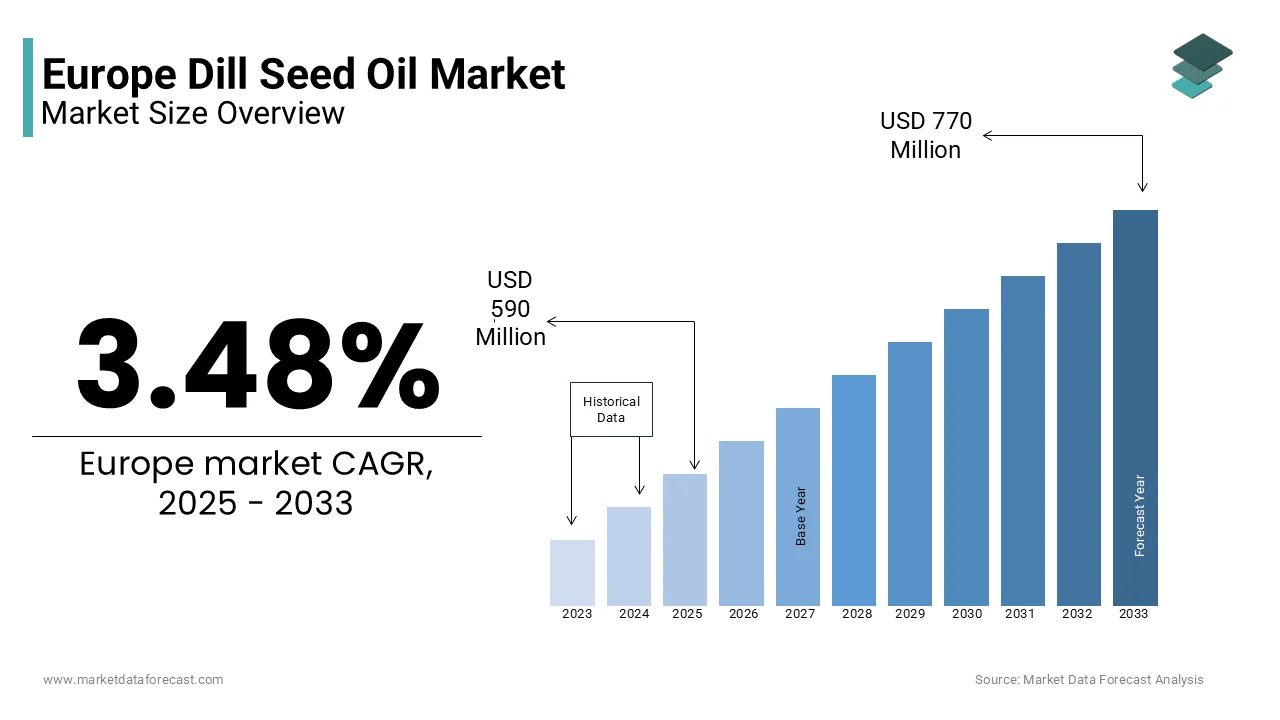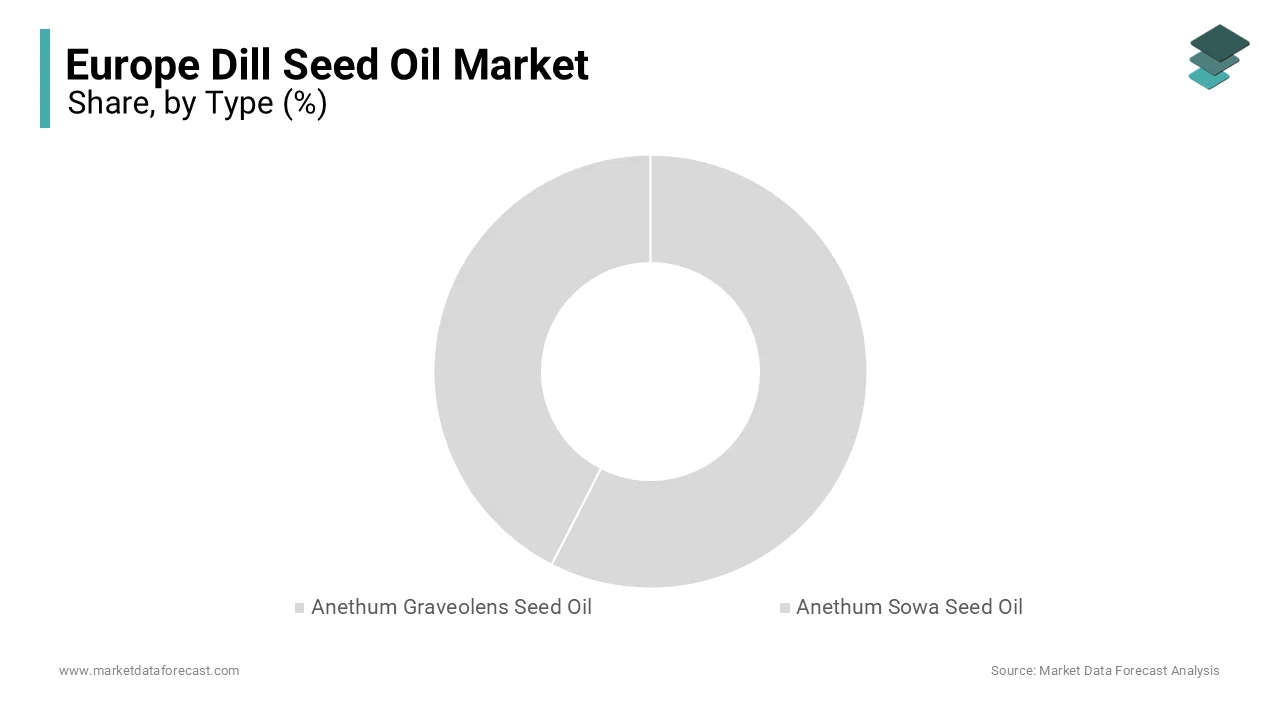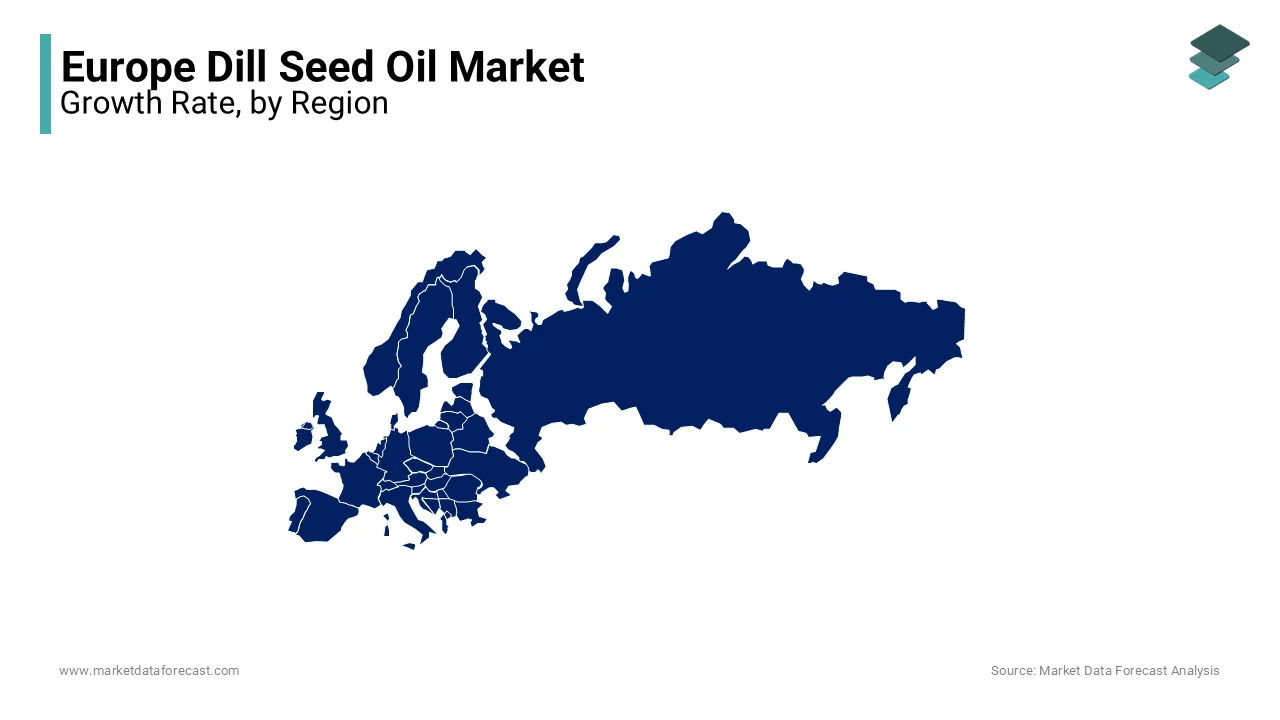Europe Dill Seed Oil Market Size, Share, Trends, & Growth Forecast Report By Type (Anethum Graveolens Seed Oil and Anethum Sowa Seed Oil), Application (Flavor, Fragrance, Pharmaceutical, Skincare, and Aromatherapy), Country (UK, France, Spain, Germany, Italy, Russia, Sweden, Denmark, Switzerland, Netherlands, Turkey, Czech Republic & Rest of Europe), Industry Analysis From 2024 to 2033
Europe Dill Seed Oil Market Size
The Europe Dill seed oil market was valued at USD 570 million in 2024. The European market is expected to reach USD 770 million by 2033 from USD 590 million in 2025, rising at a CAGR of 3.48% from 2025 to 2033.

The Dill Seed Oil is renowned for its culinary applications, particularly in flavoring and seasoning, as well as its therapeutic properties in aromatherapy and skincare. The market has gained traction due to the increasing consumer preference for natural and organic products, which has been further accelerated by the growing awareness of health and wellness. The versatility of dill seed oil extends beyond culinary uses; it is also employed in the pharmaceutical industry for its potential health benefits, including digestive support and anti-inflammatory properties. The rising trend of incorporating essential oils into personal care products has further bolstered the market, as consumers seek natural alternatives to synthetic ingredients. The interplay of consumer preferences, regulatory frameworks, and innovative applications will shape the future trajectory of the Dill Seed Oil market in Europe.
MARKET DRIVERS
Growing Demand for Natural Ingredients
The increasing consumer inclination towards natural and organic products is a significant driver of the European Dill Seed Oil market. There is a marked shift towards natural alternatives in food, cosmetics, and pharmaceuticals as health-conscious consumers become more aware of the potential adverse effects of synthetic additives. This trend is particularly pronounced in the food and beverage sector, where dill seed oil is valued for its flavor-enhancing properties and health benefits.
Moreover, the rise of clean-label products, which emphasize transparency and the absence of artificial ingredients, has further propelled the demand for dill seed oil. Manufacturers are increasingly incorporating this oil into their formulations to cater to the growing consumer preference for products that are perceived as healthier and more environmentally friendly. As a result, the European Dill Seed Oil market is well-positioned to benefit from this trend, with opportunities for growth across various sectors, including food, cosmetics, and wellness.
Expansion of Aromatherapy and Wellness Trends
The burgeoning interest in aromatherapy and holistic wellness practices is another key driver of the European Dill Seed Oil market. The demand for essential oils, including dill seed oil, has surged as consumers increasingly seek natural remedies for stress relief, relaxation, and overall well-being. Dill seed oil, known for its calming and soothing properties, is gaining popularity among consumers looking to enhance their wellness routines.
The integration of dill seed oil into various wellness products, such as diffusers, massage oils, and skincare formulations that further promotes its importance in the market. Additionally, the rise of wellness tourism and spa culture in Europe has created new avenues for the application of essential oils, including dill seed oil, in therapeutic treatments. The European Dill Seed Oil market is poised for substantial growth, which is driven by the increasing consumer focus on natural and holistic health solutions.
MARKET RESTRAINTS
Regulatory Challenges and Compliance
One of the significant restraints affecting the European Dill Seed Oil market is the complex regulatory landscape governing the use of essential oils. The European Union has established stringent regulations regarding the safety and efficacy of natural products, including dill seed oil. Compliance with these regulations can be challenging for manufacturers for small and medium-sized enterprises (SMEs) that may lack the resources to navigate the regulatory framework effectively. According to the European Chemicals Agency, the costs associated with compliance can reach up to €1 million per product by posing a financial burden on smaller companies.
Furthermore, the evolving nature of regulations is concerning labeling and safety assessments that can create uncertainty in the market. Manufacturers must continuously adapt to changing requirements, which can lead to delays in product launches and increased operational costs.
Price Volatility of Raw Materials
Another notable restraint is the price volatility of raw materials used in the production of dill seed oil. The primary source of dill seed oil is the dill plant, which is subject to fluctuations in supply due to factors such as climate conditions, agricultural practices, and market demand. According to the Food and Agriculture Organization, the price of dill seeds has experienced significant fluctuations, with prices varying by as much as 30% year-on-year in recent years. This volatility can impact the production costs of dill seed oil that is leading to unpredictable pricing for manufacturers and consumers alike.
Additionally, the increasing competition for agricultural land and resources can further exacerbate supply chain challenges, affecting the availability and pricing of dill seeds. The price volatility of raw materials poses a significant challenge for the European Dill Seed Oil market. Companies must implement effective supply chain management strategies to mitigate the impact of these fluctuations and ensure stable pricing for their products.
MARKET OPPORTUNITIES
Rising Popularity of Functional Foods
The increasing consumer interest in functional foods presents a significant opportunity for the European Dill Seed Oil market. Functional foods, which are designed to provide health benefits beyond basic nutrition, are gaining traction among health-conscious consumers. Dill seed oil, known for its potential digestive and anti-inflammatory properties, aligns well with this trend. Manufacturers can capitalize on this opportunity by incorporating dill seed oil into various functional food products, such as dietary supplements, health beverages, and fortified foods. The versatility of dill seed oil allows for its application in a wide range of formulations, catering to diverse consumer preferences.
Growth of the Natural Cosmetics Sector
The expanding natural cosmetics sector offers another promising opportunity for the European Dill Seed Oil market. The demand for natural and organic cosmetics has surged as consumers increasingly seek products that are free from synthetic chemicals and harmful additives. Dill seed oil, with its nourishing and soothing properties is gaining popularity as an ingredient in skincare formulations. Manufacturers can leverage this opportunity by developing innovative cosmetic products that incorporate dill seed oil, targeting consumers who prioritize natural ingredients in their beauty routines. The versatility of dill seed oil allows for its use in various applications, including moisturizers, serums, and hair care products.
MARKET CHALLENGES
Competition from Alternative Essential Oils
One of the primary challenges facing the European Dill Seed Oil market is the intense competition from alternative essential oils. The market for essential oils is highly fragmented, with numerous players offering a wide range of products derived from various plant sources. This competitive landscape can pose challenges for dill seed oil manufacturers in terms of market share and pricing.
Moreover, the growing popularity of alternative essential oils, which are often perceived as more versatile or beneficial, can impact the demand for dill seed oil. Consumers may opt for these alternatives based on their established reputation or perceived efficacy, leading to potential market share erosion for dill seed oil. The manufacturers must focus on differentiating their products through effective marketing strategies with the unique benefits and applications of dill seed oil to capture consumer interest.
Consumer Awareness and Education
Another significant challenge is the need for increased consumer awareness and education regarding the benefits and uses of dill seed oil. While the market for essential oils is expanding, many consumers remain unfamiliar with the specific properties and applications of dill seed oil. According to a survey conducted by the European Consumer Organisation, nearly 40% of consumers expressed a lack of knowledge about the benefits of various essential oils, including dill seed oil. This lack of awareness can hinder market growth and limit the potential customer base for manufacturers.
To overcome this challenge, industry stakeholders must invest in educational initiatives and marketing campaigns that promote the benefits and versatility of dill seed oil. Manufacturers can enhance consumer understanding and drive demand by providing consumers with information on its culinary, therapeutic, and cosmetic application. Additionally, collaborations with health and wellness influencers can further amplify awareness and encourage consumers to explore the benefits of dill seed oil in their daily lives.
REPORT COVERAGE
|
REPORT METRIC |
DETAILS |
|
Market Size Available |
2024 to 2033 |
|
Base Year |
2024 |
|
Forecast Period |
2025 to 2033 |
|
CAGR |
3.48% |
|
Segments Covered |
By Type, Application, and Country |
|
Various Analyses Covered |
Regional & Country Level Analysis, Segment-Level Analysis, DROC, PESTLE Analysis, Porter’s Five Forces Analysis, Competitive Landscape, Analyst Overview on Investment Opportunities |
|
Countries Covered |
UK, France, Spain, Germany, Italy, Russia, Sweden, Denmark, Switzerland, Netherlands, Turkey, Czech Republic, and Rest of Europe |
|
Market Leaders Profiled |
Arganisme, Lalla Izza, OLVEA, Nadifi Argan, BioAdorates, Oriental group, Vima Souss, Madanargan, Malak Bio, Zineglob, and Sidi Yassine. |
SEGMENTAL ANALYSIS
By Type Insights
The Anethum graveolens seed oil segment was the largest and held significant share of the European dill seed oil market share in 2024. This dominance can be attributed to the widespread cultivation and utilization of Anethum graveolens, commonly known as dill, in culinary applications. The oil extracted from these seeds is highly valued for its flavor-enhancing properties by making it a popular choice among food manufacturers and culinary professionals. The importance of the Anethum graveolens seed oil segment lies in its versatility and broad range of applications. Beyond culinary uses, this oil is also employed in the pharmaceutical and cosmetic industries for its potential health benefits and soothing properties. The demand for Anethum graveolens seed oil is expected to continue its upward trajectory as consumer preferences shift towards natural and organic ingredients.

The Anethum sowa seed oil segment is gearing up with a CAGR of 8.2% during the forecast period. This growth can be attributed to the increasing recognition of Anethum sowa is commonly known as Indian dill or shahi jeera, for its unique flavor profile and potential health benefits. The rising trend of incorporating international flavors into European cuisine is a key driver of growth in the Anethum sowa seed oil segment. The demand for unique and aromatic oils like Anethum sowa is expected to increase as consumers become more adventurous in their culinary choices. Additionally, the potential health benefits associated with this oil, including digestive support and anti-inflammatory properties, further enhance its appeal.
By Application Insights
The flavor segment dominated the market and held 50.2% of the European Dill Seed Oil market share in 2024. This dominance is primarily driven by the widespread use of dill seed oil in the food and beverage industry, where it is valued for its distinctive flavor and aroma. The growing prominence for the flavor segment lies in its critical function in food formulation. Dill seed oil is commonly used in pickles, sauces, dressings, and marinades is contributing to the overall flavor profile of these products. The increasing consumer preference for natural and organic flavoring agents further reinforces the demand for dill seed oil in the flavor segment.
The fragrance segment is a projected to register CAGR of 7.5% during the forecast period. This growth can be attributed to the rising demand for natural and organic fragrances in the cosmetics and personal care industry. Dill seed oil, known for its unique aroma and potential therapeutic properties is gaining popularity among consumers seeking clean and effective fragrance solutions. The increasing trend of incorporating essential oils into personal care products, such as perfumes, lotions, and candles leverages the importance of the fragrance segment. The demand for natural alternatives like dill seed oil is expected to rise as consumers become more aware of the potential harmful effects of synthetic fragrances.
REGIONAL ANALYSIS
Germany was the top performer in the European Dill Seed Oil market by accounting for 25.3% of share in 2024. This dominance can be attributed to the country's robust food and beverage industry, which places a high demand for natural flavoring agents, including dill seed oil. Dill seed oil is widely used in various culinary applications, including pickles, sauces, and dressings by making it a staple in German cuisine. Moreover, Germany's stringent regulations regarding food safety and quality further enhance the market for dill seed oil. The emphasis on clean-label products and transparency in ingredient sourcing aligns with the growing consumer demand for natural flavoring agents.

France is ascribed to hit a CAGR of 6.3% during the forecast period. The French culinary tradition places a strong emphasis on flavor, making dill seed oil a valuable ingredient in various dishes. Dill seed oil is particularly popular in French pickling and seasoning applications by contributing to its significance in the market. Additionally, the rising trend of gourmet cooking and the popularity of artisanal food products further bolster the demand for dill seed oil in France. The French market is well-positioned for growth as consumers seek unique and high-quality ingredients to enhance their culinary experiences. The combination of a rich culinary heritage and a focus on natural ingredients ensures that France remains a key player in the European Dill Seed Oil market.
The United Kingdom is likely to grow steadily in the foreseen years. The UK's food and beverage sector is characterized by a growing demand for natural flavoring agents in the context of clean-label products. Moreover, the increasing consumer awareness of health and wellness is driving the demand for natural and organic ingredients in the UK. Dill seed oil, known for its potential health benefits and culinary versatility that is gaining traction among consumers looking for clean and effective flavoring solutions. The UK market is expected to maintain its relevance in the European Dill Seed Oil landscape by providing opportunities for innovation and product development.
Italy is more likely to grow with steady growth rate during the forecast period. The Italian culinary tradition places a strong emphasis on flavor by making dill seed oil a valuable ingredient in various dishes in pickling and seasoning applications. The rising trend of gourmet cooking and the popularity of artisanal food products further bolster the demand for dill seed oil in Italy. The Italian market is well-positioned for growth as consumers seek unique and high-quality ingredients to enhance their culinary experiences. The combination of a rich culinary heritage and a focus on natural ingredients ensures that Italy remains a significant player in the European Dill Seed Oil market.
KEY MARKET PLAYERS
The major players in the Europe Dill seed oil market include Arganisme, Lalla Izza, OLVEA, Nadifi Argan, BioAdorates, Oriental group, Vima Souss, Madanargan, Malak Bio, Zineglob, and Sidi Yassine.
MARKET SEGMENTATION
This research report on the Europe Dill seed oil market is segmented and sub-segmented into the following categories.
By Type
- Anethum Graveolens Seed Oil
- Anethum Sowa Seed Oil
By Application
- Flavor
- Fragrance
- Pharmaceutical
- Skincare
- Aromatherapy
By Country
- UK
- France
- Spain
- Germany
- Italy
- Russia
- Sweden
- Denmark
- Switzerland
- Netherlands
- Turkey
- Czech Republic
- Rest of Europe
Frequently Asked Questions
What is driving the growth of the Europe dill seed oil market?
The market is growing due to increasing demand in pharmaceuticals, food & beverages, cosmetics, and aromatherapy industries.
Which industries are the primary consumers of dill seed oil in Europe?
Key industries include food & beverages, pharmaceuticals, cosmetics, perfumery, and aromatherapy.
How does the growing demand for natural and organic products impact the dill seed oil market?
Increasing consumer preference for organic and plant-based ingredients is boosting the demand for pure and sustainably sourced dill seed oil.
What is the future outlook for the Europe dill seed oil market?
The market is expected to grow due to rising interest in natural remedies, expanding use in cosmetics and food applications, and increasing consumer awareness of essential oils.
Related Reports
Access the study in MULTIPLE FORMATS
Purchase options starting from $ 2000
Didn’t find what you’re looking for?
TALK TO OUR ANALYST TEAM
Need something within your budget?
NO WORRIES! WE GOT YOU COVERED!
Call us on: +1 888 702 9696 (U.S Toll Free)
Write to us: [email protected]